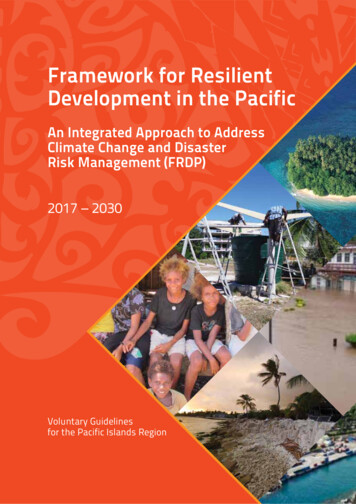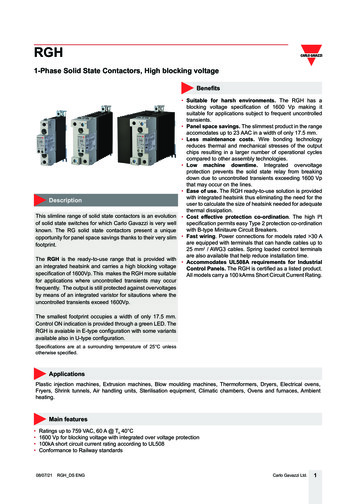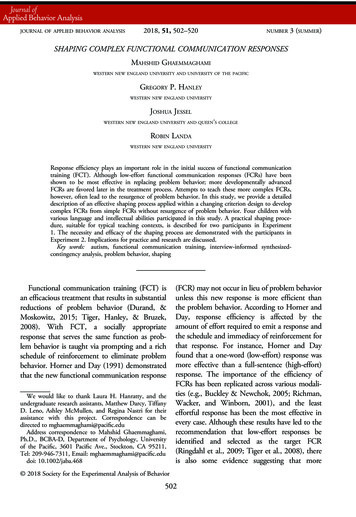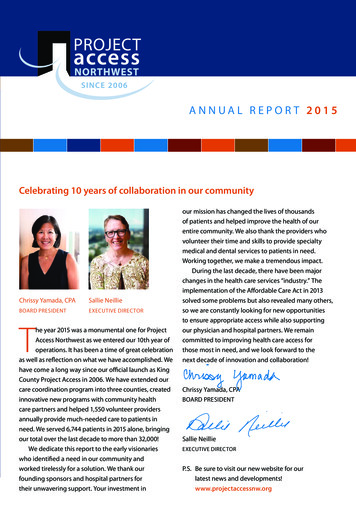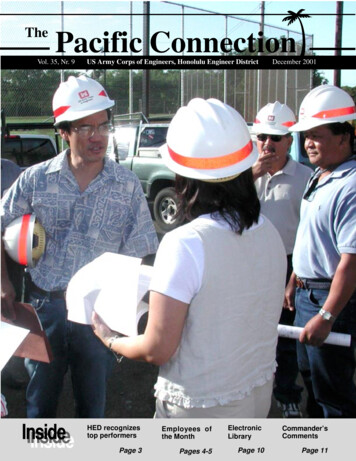
Transcription
ThePacific ConnectionVol. 35, Nr. 9InsideInsideInsideUS Army Corps of Engineers, Honolulu Engineer DistrictHED recognizestop performersEmployees ofthe MonthPage 3Pages 4-5ElectronicLibraryPage 10December 2001Commander’sCommentsPage 11
2The Pacific ConnectionOpinionThe art ofcommunication:Thenand nowBy Maj. Scott SchrinerDeputy CommanderWhen I was younger, the rotary phone was the standard.You actually had to “dial” each number, meaning that your fingerfollowed it around the circle and speed never really was part ofthe equation because you waited for the dial to return to zeroafter each digit. You were considered lucky if you had a privateline. Our family had a party line. Neighbors could listen in onyour calls at will.Technology advanced and those of us out in the “sticks”were next afforded the opportunity to have a private line. Oh,what a blessing it was! No more guessing whether the phone callwas really for your residence or that it bled over from your partyline partners.Leap forward a few years and push button phones are in.No more “dialing.” It might even be more appropriate to sayyou’re going to punch someone’s number, but we don’t want toget into trouble do we? With modern telephones, you can evenflip a switch from pulse to tone depending on your telephonecompany’s equipment and services offered.Nowadays, things are changing again. An increasingmajority of communication services include cellular phones andare email-based. If I asked my nephew to describe a rotaryphone, I would probably get that dazed and confused looksuggesting that once again I was proving that I came fromanother planet. And, since I have indeed mastered the telephoneand am not fully satisfied with the shortcomings of email, hemight have something there.As many of you know, I am not a fan of using email forroutine communicating when a phone call or personal visit servesthe purpose much better. I particularly don’t like email when it isused as a method of leadership or counseling. It isn’t. I feel it issheer laziness. It is too easy to sit behind a desk and fire out 100On the cover: Gerald Young talks to new employees ata project site as part of a new HED initiative designedby Maj. Scott Schriner, Deputy Commander. The twoday overview helps familiarize new employees to HEDby introducing them to all of the different divisionswithin the District so they can better understand howthey fit into the big picture. —Photo by Michelle Cain.The Pacific Connection, an unofficial publication authorized byAR360-1, is a monthly newspaper produced by the Public AffairsOffice, Pacific Ocean Division and Honolulu Engineer District, USArmy Corps of Engineers, Fort Shafter, HI 96858-5440. Telephone(808) 438-9862. This command information newspaper is for employees and others who request it in writing. Contents are notnecessarily the official views of, or endorsed by, the U.S.This newspaper is printed Government, the Department of Defense or the Department of theon recycled paper.Army. Circulation: approximately 1,300.December 2001emails within an hour telling people what they need to do andexpect immediate results. Also, the assumption is that once thesender sends the email, the receiver immediately reads it and actsupon it. Wrong assumption! Do you know what they had plannedfor today? Are they even in the office? Maybe they’re on leave?You can’t get this by sending out electrons alone. You get it onlythrough complete communications.Let me throw a few scenarios at you and you pick the rightanswer.1) Email is an effective way to send one liners back andforth between employees sitting less than 20 yards apart.a. True.b. False.2) It is great to attach as many names as possible on the cc:when you are chastising a fellow employee in order to humiliatethem in front of their peers, subordinates, superiors.a. True.b. False.3) Email is an ineffective way of communicating withmany people all around the world, sending files back and forth,when the USPS has been in business a lot longer and could useyour support.a. True.b. False.4) It is perfectly acceptable for a leader to use email toconduct quarterly counseling in order to avoid talking personallywith the employee.a. True.b. False.If you answered false to all of the above, I am glad to haveyou on my team. If you thought that some of the answersdeserved a true response, I’d like to see you reevaluate thesituation. Another of my pet peeves is the misuse of the “replyall” from a “Dist A” message. There are valid reasons to use the“Dist A” option. I have used it a few times when speed is of theessence when gathering information. The voting button optionalso is great. It provides an extremely fast way of gathering andtabulating data. What irks me is the use of reply all from a “DistA” message. If you have a problem, concern, issue, contact thesender directly (via office visit or phone call). Don’t waste otherfellow employees’ time making them read your rebuttal. Onefinal note here, USE SPELL CHECK!Okay, so I have been bashing email. Like any tool, it can bemisused. There is a good side to email. We can reach out worldwide, day or night, to contact a colleague at the far reaches of theglobe without having to match time zones when trying to callthem. Just send a message and wait for their reply. It is also greatto send files back and forth. It sure beats waiting for the postalsystem to deliver the mail, especially in these difficult times ofincreased security.Remember, one of Lt. Gen. Flowers’ three strategic goals iscommunication. Also, Brig. Gen. Johnson is interested in it aswell. He paid us a visit on November 19 and asked for our helpwith internal communications. Reading between the lines, whichwasn’t hard, we need to lead people through personal communications, not by conducting artificial counseling hiding behindemail.Honolulu Engineer District Commander.Lt. Col. Ronald N. LightChief, Public Affairs .Douglas S. MaKittenPublic Affairs Specialist.Alexander KufelEditor .Michelle Cain
December 2001The Pacific Connection3HED recognizes top performersBy Doug MaKittenHonolulu Engineer District recognized its top performers in a Dec. 7ceremony at Fort Shafter that introduced anew awards program to the District.The District’s Tripler Army MedicalCenter Project Delivery Team earned the HuiO’i Loa (Hawaiian for being the best team)award for its outstanding work on the Triplerlaser eye surgery and vascular laboratoryprojects.Team members include the projectmanager Randall Kurashige, Jody Muraoka,Michael Onuma, James Pak, Dixon Park,Brad Scully, Allyn Tabata, Aaron Tashiro,Linda Tsugawa and Richard Yoshimura.Raymond Kishaba received the“Alaka’i (one with personal strength whoexhibits leadership quality) award as theDistrict’s project manager of the year.Raymond Kong received the Maika’iLoa (mighty, achieving excellence) as theDistrict’s leader of the year.Three employees received Ikaika Loa(power of knowledge, professional skills andexpertise) awards.HED’s Tripler Army Medical Center Project Delivery Team members are therecipients of the Hui O’i Loa award for their work on the TAMC laser eyesurgery and vascular laboratory projects. The award is one of several presented as part of the HED’s new awards program. —Photo by Michelle CainJeannette Anderson was named Administrative Employee of the Year.Ernesto Guerrero was named Techni-cal Employee of the Year.Olson Okada was named ProfessionalEmployee of the Year.David Okada, HEDDesign Branch civilengineer, does apreliminary damageassessment of thePago Bay Bridgewith representatives of the GuamWaterworksAgency. The bridgesustained damageto a water main during an earthquakethat struck the island on October 13.—Photo by DonYorimoto.Perspective:A child on a farm sees a plane fly by overhead and dreams of a faraway place. A traveler onCarnsthe plane sees the farmhouse and dreams of home. —CarCarll BurBurns
4The Pacific ConnectionDecember 2001Employees of the MonthJesse DuarteRandall KurashigeHometown: Corpus Christi, TexasFamily: Wife, DarlenePosition with Corps and how long: Civil engineer for 13monthsDescribe your job in 50 words or less: My job as theConstruction Services Branch Chief, in a nutshell, is tokeep the projects moving as smoothly as possible administratively, and to assist where appropriate with civil/technicial issues.What do you like best about your job? Part of thesatisfaction comes from resolving problems which otherwise would impact contract schedules, dissatisfy thecustomer, or add cost to the project. There’s also adistinct sense of accomplishment in seeing a project tofruition.What is the most difficult part of your job? Balancingtime against customer/contractor demands.If I was the DE for a day, I would. consider buying abig morale booster like a jetski, motorboat, or other craftfor occasional island hops. (I know. wishful thinking!)What is the best improvement in the District in the pastsix months? I suppose that for the District that would bethe office furniture.What is the best improvement in your office in the pastsix months? The addition of my wife to our team (I’ve justearned brownie points!), and our new server.Hometown: Honolulu, HawaiiFamily: Wife, Rae and daughters, Lauren (13) andJodi (4)Position with Corps and how long: Project manager inPrograms and Project Management Division. Twentyyears of federal service, all with the Corps.Describe your job in 50 words or less: I get projectsdesigned and constructed. I need to ensure that the expectations of my customers are met or exceeded so that theyare satisfied. I do this by trying to ensure quality, controlcosts, and stay on schedule.What do you like best about your job? The opportunityto work with people. I have had a chance to work with verygood folks in this job. I have benefitted greatly from thisinteraction.What is the most difficult part of your job? Havingenough time to accomplish all the things I want to get doneand still have time for family.If I was the DE for a day, I would. I don’t know if I woulddo anything differently.What is the best improvement in the District in thepast six months? Furniture is the most visible improvement. It seems a lot of effort has been put into improvingthe workplace.What is the best improvement in your office in the pastsix months? We’ve gotten a lot of new folks on board, andwe all have nice places to work in, too.Challenges:Challenges are what make life interesting. Overcoming them is what makes life meaningful. —Joshua Marine
December 2001The Pacific Connection5Employees of the MonthSally MinamiRichard SayHometown: Aiea, HawaiiPosition with Corps and how long: Program andbudget analyst with the Corps for 24 years. Started in 1978with the Middle East Division in Winchester, Va.Describe your job in 50 words or less: We’re responsible for coordinating the development, execution andanalysis of the District’s operating budgets; processingdirect and reimbursable funds; and performing studies andpreparing briefs on cost trends, overhead, performanceindicators, etc.What do you like best about your job? No matter howstressful or overwhelming a job can be, it’s incrediblehow people are willing to share their ideas, knowledge,and candid opinions to help us get the job done.What is the most difficult part of your job? I’m all forchange, but find it difficult to accept mandated changeafter change with no meaning or purpose and consolidation of functions across the ocean. We’ll miss ourfriends here who must leave us and move on to otherjobs.If I was the District Engineer for a day, I would. relax,trust that the work will be done well by the people in thisdistrict, and have fun. Guess I’d lose this job in less thana day.What is the best improvement in the District in thepast six months? Information overload and too much toread, but at least it’s interesting to know what’s going onwith the rest of the Corps.What is the best improvement in your office in thepast six months? The good news here is that we finallyhave a new RM and new manpower analyst on board.Hometown: Honolulu, HawaiiFamily: Wife, Marion and son, Nathan (senior atWaipahu High School)Position with Corps and how long? General attorneywith HED for four months, previously with the Kansas CityDistrict for 10 years.Describe your job in 50 words or less: My job is to findways to avoid problems. If we can’t avoid a problem, I try toshow that the Corps position was correct. At HED I workprimarily with issues involving government contracts, fiscallaw, real estate, and ethics.What do you like best about your job? Successfullyarguing a point and having my position sustained (WINNING).What is the most difficult part of your job? Identifying andanalyzing the effect of the numerous laws, regulations,cases, and guidance memoranda that can affect the outcome over the wide range of Corps of Engineers activities.If I was the DE for a day, I would. try to impress uponeveryone how important it is to do the job completely andcorrectly, particularly regarding those duties that seemdifficult or distasteful.What is the best improvement in the District in thepast six months? I have only been here four months but,from the perspective of one who has defended a few bidprotests since my arrival, I would say that recent effortsto improve the contractor selection processes should behigh on the list.What is the best improvement in your office in the pastsix months? I don’t know how things were here six monthsago. However, I hope that I have lightened the workload forthe other OC staff and that I can contribute to more improvements in the future.Enthusiasm:You can do anything if you have enthusiasm. Enthusiasm is the yeast that makes your hopes risey Fordto the stars.—Henr—HenryFord
The Pacific Connection6December 2001“The stockings werehung in Office ofCounsel with care.”—Photo by MichelleCainHED celebratesthe holidaysAbove right: ShirleyKoga and DonnaKanetake, OC, wrappackages to giveaway. OC, with helpfrom CT, adopted afamily in need thisChristmas. At right:Clifford Olivera, LM,accepts the first-placeaward from ClarenceWilhelm, Fort ShafterChristmas card committee director. Oliveraspent many hours ofhis own time creatingHED’s entry. —Photosby Michelle CainWords:ords:Many wise words are spoken in jest, but they don’t compare with the number of stupid words spoken in earnest.—Sam Levenson
The Pacific Connection7Holiday greetings fromthe Chief of EngineersThe holiday season is traditionally a time to pause and reflect on thepast year, and the challenges of the coming year. I m sure you will all agree thatthis past year has given us a lot to think about. And we have much to be thankfulfor, both as an organization and as individuals.I am personally thankful that no Corps employees were lost during theterrible attacks on Sept. 11. And I am thankful to have the opportunity to leadour great organization with some of the finest people in the U.S. government.You all proved that this past year, and I am very proud of you.Although the terrorist attacks are foremost in our minds, they were not theonly emergency operations we faced in 2001. After an ice storm in Oklahoma lastChristmas, our employees cleaned up tree debris at their projects, often workingwithout electricity, phones, or water. Additionally, Tulsa District delivered250,000 gallons of water to stricken counties.Seattle District rode out a magnitude 6.8 earthquake, then went into immediate action in support of the Federal Emergency Management Agency (FEMA),and to assess the integrity of Corps projects in the area.We took part in a flood-fight last spring in the upper Midwest. We distributed 3.2million sandbags to local communities, and Corps emergency work (mostly levee building)prevented more than 50 million in damage to North Dakota and Minnesota cities.Corps personnel responded to Tropical Storm Allison. They supplied emergency power, temporary housing, debris removal and monitoring, distributed 100,000sandbags, and provided utility hook-ups for 950 temporary housing trailers.All that, plus our normal work-load supporting Army Transformation,environmental restoration at military and civil works sites, research and development, building housing and other facilities for the Air Force and Army, civil worksprojects throughout the country, and support for others, just to name a few.But the terrorist attacks on the World Trade Center and the Pentagon havedominated our thinking and emotions. I m enormously proud of the work wedid on Sept. 11 and the days following.At both the World Trade Center and the Pentagon, we had people on the groundin less than two hours assessing the situation and lending assistance. We had literallythousands of volunteers to help in New York, and the city welcomed the work they didthrough FEMA structural response, temporary power, debris removal, and more.The Corps response to the terrorist attacks was tremendous, and I couldn t bemore proud of you all. But work that intense takes a lot out of you, plus the uncertaintiesof the war against terrorism and what the future holds adds additional strain.I would appreciate it if everyone would take extra care of each other in thecoming year. There is no one better able to assess how people are feeling thanthose around them. Look each other in the eye now and then and earnestly ask, How s it going? Then listen and help each other.Our entire country seems to be drawing closer together and reaching out tohelp others, a little more aware of what s important in life, and of our need foreach other. If we in the Corps of Engineers continue to be thankful for ourblessings, and keep reaching out to one another, we will be more than ready totackle the challenges that next year will bring.My family joins me in wishing you a safe and joyous holiday season, anda happy, exciting New Year. Take some well-deserved time off, relax, and enjoybeing with your family and friends.Essayons!ROBERT B. FLOWERSLieutenant General, USACommandingCourage:Above: Pauline Kahalioumi, IM, and Rolando Castillo, LM, unload a truck-load of toys, clothing, and household items at theCommunity Clearinghouse. HED employees donated two pickup trucks full of items, including 689 pounds of food that wasdropped off at the Hawaii Food Bank. —Photo by Michelle CainHEDcelebrates theholidaysThey may be trying to disguise themselves, but we know ourleaders when we see them! Maj. Scott Schriner, DDE, Ray Jyo, PP,Lt. Col. Ronald Light, DE, and Sam Song, EC, enjoy a game at theSEPC Christmas party. —Photo by Donna KanetakePain nourishes courage. You can’t be brave if you’ve only had wonderful things happen to you.—Mary Tyler Moore
8The Pacific ConnectionDecember 2001Spotlight on HEDEngineering andConstruction DivisionSpotlighting an office that is helping to make the Honolulu Engineer District“The Best Place for the Best People to Work.”Interview and photoby Michelle CainThis month I talked with JimBersson, HED’s Chief of Engineering and Construction, to find outhow his organization contributes to theoverall mission of the District.Pacific Connection (PC): What is E&C?Jim Bersson (JB): Engineering andConstruction Division (E&C) is the largestdivision in HED, comprised of approximately 230 engineers, architects, scientists, technicians, and administrativepersonnel. We are divided into sevenbranches: Design; Cost Engineering; CivilWorks Technical; Engineering Services;Environmental Technical; Regulatory; andConstruction, which is our largest branchand includes four resident offices. Theyare located at Ft. Shafter, SchofieldBarracks, Kwajalein, and Palau.PC: What are some of the responsibilities that fall under the E&C umbrella?JB: E&C’s responsibilities are many anddiverse. They include virtually all theservices the District provides its customers. To put it another way, E&C providesservices necessary to plan, design,construct, and (in some cases) maintainmilitary, civil works, environmental, andsupport of other agency projects throughout the Pacific region. E&C also providesengineering services for other PODdistricts, operates a Regional Visitor’sCenter at Ft. DeRussy, and administers theDepartment of the Army (DA) RegulatoryProgram in Hawaii and U.S. possessionsin the Pacific.Humor:PC: What is the DA Regulatory Program?JB: Department of the Army permits arerequired for all construction and dredgingin navigable waters of the United States;for projects discharging fill into jurisdictional waters of the United States, including wetlands; and for transportation ofdredged material for the purpose of oceandisposal. The program is unlike anything“ First and foremost ismaintaining the capability to provide superior services to our customers.”— Jim Berssonelse we do in that we are acting in aregulatory capacity, as opposed to as aproject proponent. It is also highly visibleto the public and can be quite controversial.PC: Who does E&C deal with outside ofHED?JB: E&C deals with many organizationsand entities outside of HED. Theseinclude: customers, local and foreigngovernment officials, the general public,architect-engineer firms, constructioncontractors, the media, Pacific OceanDivision(POD) and other POD districts,and USACE Headquarters, laboratories,and centers of expertise such as theProtective Design Center in Omaha. E&Calso maintains close ties with localindustry organizations to include theAmerican Institute of Architects, theConsulting Engineers Council of Hawaii,the General Contractors Association, theBuilding Industry Association, theAssociated Builders and Contractors, andothers. We hold an annual workshop withthese organizations where we provideinformation and exchange ideas.PC: What engineering services doesE&C provide other POD districts?JB: In the past year we provided design,technical review, cost engineering, claimssupport, contract negotiations, andenvironmental support services to theother POD districts. HED has beendesignated a regional technical reviewcenter within POD, which the otherdistricts use to augment their own capabilities in this area.PC: What is E&C’s role in the ProjectManagement Businesss Process(PMBP)?JB: E&C folks perform technical servicesand form the bulk of project deliveryteams, or PDT’s. Most of our PDT’sinclude environmental specialists, costengineers, designers, design reviewers,negotiators, and construction managers.These and other PDT members are criticalto the success of our projects. In somecases, E&C folks serve as the projectmanager in addition to their technical role,particularly for projects with a narrowscope, such as an environmental study.PC: How do you ensure that everyone inyour division is trained and current intheir professional qualifications?JB: Obtaining professional registration forfolks in job series such as engineering orarchitecture is highly encouraged. ThereThe most wasted of all days is that on which one has not laughed. —Nicholas-Sebastian Chamfort
December 2001The Pacific Connectionhas been an increased emphasis on this inUSACE. Some positions require registration as a prerequisite for selection.Everyone is required to maintain anindividual development plan which isgeared toward accomplishing the missionrequirements of each branch in E&C.Supervisors and employees reviewtraining needs annually and programneeded training. They also take advantageof unscheduled training that is relevant tomission areas. An example of the latter isunscheduled training we sent key peopleto in anti-terrorism/force protection, whichhas received increased emphasis in theaftermath of September 11th. We also holdmonthly technical seminars for our folks.PC: What role do the field offices playin accomplishing the E&C mission?JB: Our construction resident offices arekey to the accomplishment of not just theE&C mission, but the District’s mission asa whole. The resident office folks administer and manage construction projects,negotiate modifications, and ensure theprojects are constructed in accordancewith the contract documents. As ourrepresentatives at installations and projectlocations, they have frequent contact withcustomers and perform a myriad ofcooordination activities to facilitateconstruction. An example occurred duringthe high threatcon levels in the aftermathof September 11th, when our folks spentcountless hours assisting contractors gainaccess to military installations, thusminimizing delays to projects. Our projectengineers are also responsible for ensuringthat contractors adhere to the safetyrequirements in their contracts.We also maintain a small regulatoryfield office in Guam. Its primary missionis to administer the DA regulatoryprogram in Guam and the CNMI, but theoffice also acts as the District’s forwardpresence in that part of the world andassists the District Headquarters in anumber of ways, such as by facilitatingcontact with local governmnent officials.PC: What are some of the challengesthat face E&C?JB: First and foremost is maintaining thecapability to provide superior services toour customers. Continuing to do this willrequire us to shape the workforce toParenting:arenting:accomplish our current and futuremissions. This is critical in view of theincreases we foresee in our program, interms of both dollars and missions; andour mature workforce. Many of our peoplewill be eligible for retirement in the nextseveral years. We want to make sure wehave sufficient numbers of trained folks toreplace them and capture the benefits oftheir knowledge and experience. To thatend, we have been hiring. We filled 39positions since Oct. 1, 2000 and arecurrently recruiting for 10 additionalpositions. E&C also has the lead on aFY02 OPLAN initiative to develop acomprehensive human resource plan forthe District, which will focus on this issuefor the long and near term.Another challenge is to continue toleverage technology. We rely heavily onautomation, such as Computer AssistedDrawing and Design (CADD) andDrChecks (an automated design reviewand lessons learned system), to increaseour productivity and accomplish our work.We need to continue to stay abreast oftechnological advances and ensure arepeople are trained. We are implementing aTechnology Integration Group withinE&C to help us do that.Improving our business process is acontinuing challenge. The District has9come a long way with implementation ofthe PMBP; we are now involved in theISO 9001 implementation process, whichis being lead by PPM. E&C is leading ateam working on a FY02 OPLAN initiative relating to our business process - howto improve our small and routine projectexecution. It is difficult for an organizationthat manages projects in the 100 millionrange to be efficient managing projectsunder 100 thousand. The team willaddress how we can better achieve that.There are also potential challengesover which we have minimal or nocontrol, such as mandates requiringincreased use of design-build contractingand privatization. For those, all we can dois stay informed, participate in thedialogue, and adjust our plans andprocedures accordingly.PC: Do you have any final comments?JB: E&C is involved in just abouteverything the District does, but we don’tdo it alone. We’re part of a team - manyteams, in fact. It would take a lot moretime to go into much detail on the wonderful things the individual branches do but Iwould like to close by saying that ourbiggest asset is our people. They arededicated and extremely capable. Theservice they provide to our customers andto the nation is invaluable.Lolly Silva, regulatory branch, takes soil samples to determine if this possible wetland falls within HED’s jurisdiction.Good parents give their children roots and wings. Roots to know where home is, wings to fly awayand exercise what’s been taught them. —Jonas Salk
10The Pacific ConnectionElectronic Libraryby Ruby MizueCONSTRUCTION CRITERIA BASE (CCB) UPDATEFor those of you who use CCB on the network, the newedition #58 has replaced the current DVD. Instructions forupdating as well as new installations are posted in the POHPublic Folders, Information Management Folder, ElibraryConnection box.Beginning in 2002, CCB disc sets will be published twice ayear, in April and October, instead of the current quarterlyschedule. This is the final regular quarterly edition of CCB. Wewill continue to have password access to CCB On-Line (Internet)for at least one year, with even more emphasis placed on thecurrency and completeness of documents and programs availableon the CCB website.The change will enable subscribers to take advantage ofCCB On-Line for timely updating and easy access to guidespecifications and other documents which are quickly updated onthe website. Alternatively, the option of CCB on CD-ROM orDVD will continue to be the choice for very large documents(which often take impractically long to download with normalinternet connections), and for proprietary documents such ascodes and reference standards which cannot be distributed on theInternet.Visit CCB Online at: http://www.ccb.org/ for generalinformation about the electronic collection of over 10,000documents used in building design and construction. Call RubyMizue at 438-8348 if you need a username/password or assistance in using the resource.Request for Leave and Approved Absence FormIf you are still using the old familiar SF71 to submit leaverequests, you are using an obsolete form! It has been replaced byDecember 2001OPM Form 71, same title, which can be filled out electronically in Formflow at: S:\forms\formflow\OPM0071.frz. Besure you save your DATA on a diskette or your hard drive—DoNOT save your personal data on the S:\ drive!INTERNET/INTRANET UPDATETwo Commander’s Policy Memos Posted at ander’s Policy Memo #7,
HED's Tripler Army Medical Center Project Delivery Team members are the recipients of the Hui O'i Loa award for their work on the TAMC laser eye surgery and vascular laboratory projects. The award is one of several pre-sented as part of the HED 's new awards program. — Photo by Michelle Cain David Okada, HED Design Branch civil engineer .






